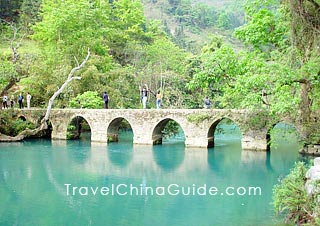Qiannan Travel Guide
Qiannan Facts
Chinese Name: 黔南布依族苗族自治州 (qián nán bù yī zú miáo zú zì zhì zhōu)
Population: 4,200,000
Area: 26,200 square kilometers (10,116 square miles)
Location: in the south-central of Guizhou Province, southwestern China
Administrative Division: 9 counties (Libo, Guiding, Weng'an, Dushan, Pingtang, Luodian, Changshun, Longli, Huishui); 1 autonomous county (Sandu Shui); 2 county-level cities (Duyun, Fuquan)
Area Code: 0854
Zip Code: 558000
GDP (2019): CNY 151.804 billion (USD 22.004 billion)
Nationalities: Han, Buyi, Miao, Shui, Maonan, Yao
The Location of China’s Eye in the Sky - Five-Hundred-Meter Aperture Spherical Telescope
 |
| Ancient Bridge, Xiaoqikong Scenic Area |
Qiannan is located in the south-central region of the Guizhou Province, neighboring Anshun and Qianxinan Buyi and Miao Autonomous Prefecture to the west, Qiandongnan Miao and Dong Autonomous Prefecture to the east, Guangxi Zhuang Autonomous Region to the south and Guiyang to the north. As a multi-ethnic settlement, Qiannan has rich ethnic customs and colorful ethnic cultures. Tourists can see wonderful ethnic dances, traditional sports such as horse racing, martial arts, and experience different traditional festivals. Unique karst landform in Libo, Shui culture in Sandu and secret of longevity in Luodian are other features of Qiannan tourism. Qiannan is also the location of five-hundred-meter Aperture Spherical Telescope, the largest single aperture and the most sensitive radio telescope in the world with independent intellectual property rights of China. Duyun Maojian tea named by Mao Zedong in 1956 is one of the top ten famous teas in China, becoming another highlight of Qiannan.
Libo: Located in southern Qiannan in the Guangxi neighborhood, Libo is a rich tourist county of the prefecture, with scenic areas occupying nearly a quarter of its territory. Libo Zhangjiang Scenic Area and Maolan Karst Forest Natural Conservation are the key attractions of the county. The former is well known for its typical and rich karst landform, water and plantation, mainly consisted of Shuichunhe Valley, Xiaoqikong and Daqikong scenic spots. Forests, caves and the stone forest in Maolan Karst Forest Natural Conservation make it a famous Guizhou resort. The Buyi, Shui, Miao and Yao are the four principal minorities of the county. Traditional festivals and customs as well as characteristic residential buildings add yet more charm to this beautiful tourist destination.
Other Scenic Spots: Doupengshan-Jianjiang National Park, Yaorenshan National Forest Park
|
|
How to get to Qiannan
Libo Airport is 13 kilometers (8 miles) away from center of Libo County, operating direct flights from/ to Chongqing, Guiyang, Guangzhou, Xi’an and Nanning. Airport shuttle bus is priority for visitors travelling between airport and downtown.
Main bus stations in Duyun City, the capital of Qiannan prefecture:
Qiannan fast passenger transport bus station: No138, Jianjiang Zhong Lu, Duyun City
Duyun long-distance bus station: Longshan Da Dao, Development Zone, Duyun City
Weather
Qiannan Travel Tips
![]() History: From the Shang Dynasty (16th - 11th century BC) to the Zhou Dynasty (11th century BC-221BC), several kingdoms established by local ethnic groups shared the prefecture. During the Qing Dynasty (1644-1911), it partly belonged to Guiyang. Qiannan Buyi and Miao Autonomous Prefecture was authorized in 1956 with Duyun as its capital.
History: From the Shang Dynasty (16th - 11th century BC) to the Zhou Dynasty (11th century BC-221BC), several kingdoms established by local ethnic groups shared the prefecture. During the Qing Dynasty (1644-1911), it partly belonged to Guiyang. Qiannan Buyi and Miao Autonomous Prefecture was authorized in 1956 with Duyun as its capital.![]() Physical Features: Located on the slopes of the southeastern Yunnan-Guizhou Plateau to the hilly regions of Guangxi, Qiannan declines from northwest to southeast. Mountains and hills constitute most of the terrain with an average altitude of 997 meters (3,271 feet).
Physical Features: Located on the slopes of the southeastern Yunnan-Guizhou Plateau to the hilly regions of Guangxi, Qiannan declines from northwest to southeast. Mountains and hills constitute most of the terrain with an average altitude of 997 meters (3,271 feet).![]() Local Highlights: The thirty ethnic minorities living there make up more than fifty-six percent of the total population. Between these Buyi and Miao are the principal minority groups. In the Miao Region, one can experience the most attractive scenery and customs of the minority. In addition, the prefecture also gathers together ninety percent of the Shui ethnic minority's total population in China. Sandu is China's only Shui minority autonomous county.
Local Highlights: The thirty ethnic minorities living there make up more than fifty-six percent of the total population. Between these Buyi and Miao are the principal minority groups. In the Miao Region, one can experience the most attractive scenery and customs of the minority. In addition, the prefecture also gathers together ninety percent of the Shui ethnic minority's total population in China. Sandu is China's only Shui minority autonomous county.![]() Special Local Products: Shui Mawei (Horse Tail) embroidery, garments and ornaments of the Shui ethnic minority in Sandu Shui Autonomous County, presents painting of Longli County, silver ornaments in Libo County, and Maojian tea
Special Local Products: Shui Mawei (Horse Tail) embroidery, garments and ornaments of the Shui ethnic minority in Sandu Shui Autonomous County, presents painting of Longli County, silver ornaments in Libo County, and Maojian tea

